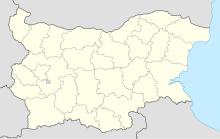Sofia Airport
|
Sofia Airport Летище София |
|||||||||||
|---|---|---|---|---|---|---|---|---|---|---|---|
 |
|||||||||||
 |
|||||||||||
| Summary | |||||||||||
| Airport type | Public | ||||||||||
| Operator | Sofia Airport EAD | ||||||||||
| Serves | Sofia, Bulgaria | ||||||||||
| Location | Vrazhdebna | ||||||||||
| Hub for | |||||||||||
| Elevation AMSL | 1,742 ft / 531 m | ||||||||||
| Coordinates | 42°41′42″N 023°24′30″E / 42.69500°N 23.40833°ECoordinates: 42°41′42″N 023°24′30″E / 42.69500°N 23.40833°E | ||||||||||
| Website | sofia-airport.bg | ||||||||||
| Map | |||||||||||
| Location in Bulgaria | |||||||||||
| Runways | |||||||||||
|
|||||||||||
| Statistics (2016) | |||||||||||
|
|||||||||||
|
Source: Bulgarian AIP at EUROCONTROL
|
|||||||||||
| Passengers | 4,980,387 |
|---|---|
| Cargo (tonnes) | 21,157 |
| Aircraft movements | 51,829 |
Sofia Airport (IATA: SOF, ICAO: LBSF) (Bulgarian: Летище София, Letishte Sofiya) is the main international airport of Bulgaria located 10 km (6.2 mi) east from the centre of the capital city Sofia. In 2015 the airport surpassed 4 million passengers for the first time and handled a total of 4,088,943 passengers, a 7.2% increase compared to 3,815,158 passengers handled in 2014. In 2016, the number rose to almost 5 million passengers. The airport serves as the home base for BH Air, Bulgaria Air, and Bulgarian Air Charter and as a base for both Ryanair and Wizz Air. The Vrazhdebna Air Base of the Bulgarian Air Force is also located at the airport.
The airport was initially built in the late 1930s on a site 6.3 km (3.9 mi) (7.5 km (4.7 mi) by road then; later 9 km (5.6 mi) by road and today 10.2 km (6.3 mi) and up to 11.4 km (7.1 mi)) distant from the geographical centre of Sofia as a replacement of that city's small civil airport at Bozhurishte. The airport was used as hub by domestic airline Bunavad which connected Sofia to Burgas, Plovdiv, Ruse and Varna. In 1938, Yugoslav airline Aeroput begin regular direct flights linking Sofia to Belgrade three times a week using Lockheed Model 10 Electra planes. The airport served Sofia which then had under 250,000 inhabitants and continues to serve the city nowadays, which had about 1.2 million by 2011.
During the Second World War, the facilities were used by the military. Mail, perishable freight and passenger operations began in 1947 from buildings on the north side of the airport. The passenger terminal (now Terminal 1) on the south side was completed during the Second World War in the manner of a then-modern European railway terminus to designs by the architect Ivan Marangozov. It opened after several years of delay in 1947. The structure comprised a government wing to the west, an international handling area in the middle, and a domestic handling area to the east. At that time, it was planned that the airport would eventually have two intersecting runways at a 30-degree angle to each other.
...
Wikipedia

